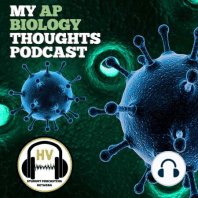11 min listen
Transcription & RNA Processing
ratings:
Length:
5 minutes
Released:
Jun 2, 2021
Format:
Podcast episode
Description
My AP Biology Thoughts Unit 5 HeredityWelcome to My AP Biology Thoughts podcast, my name is Chloe McGregor and I am your host for episode #107 called Unit 6 Gene Expression and Regulation: transcription and RNA processing. Today we will be discussing the process of transcription, and how MRNA is processed on its way to the ribosomes. Segment 1: Introduction to Transcription and RNA Processing The central dogma is the process by which the genetic information stored in DNA is converted into functional products such as proteins. This process consists of 3 steps: transcription, translation, and protein synthesis. In this episode, I will specifically discuss transcription, the process of transcribing shorter segments of DNA into mRNA strands. However, once these mRNA strands are created, there are still steps that take place to ensure that the strand is mature and ready to be translated. This is called RNA processing. The mRNA strand is manipulated into a mature strand through a series of processes, and is then ready to travel to the ribosomes for translation and protein synthesis.Segment 2: More About Transcription and RNA Processing As I mentioned earlier, transcription is the first step and this is when the DNA strand is read, and a new complementary mRNA strand is synthesized. DNA is composed of different nitrogenous bases compared to RNA. DNA consists of adenine, thymine, cytosine, and guanine. However, RNA contains uracil instead of thymine. Base pairing rules are used by RNA polymerase to synthesize a new strand using the information on the unzipped DNA strand. Transcription is very important because DNA is very unique and one of a kind, so this single strand of RNA makes it possible for the genetic information to stay safe, but also be used for protein synthesis outside of the nucleus. Following transcription, RNA processing occurs. Premature mRNA strands contain both introns and exons that are transcribed from the DNA, however, the introns are spliced out to create a concise and mature strand of RNA that is ready to be translated. Introns are removed to ensure that the correct protein is being created during protein synthesis because a mistake in the RNA strand can cause mistakes during translation. Also, if introns are kept on accident, the wrong protein can be produced which will disrupt many different cellular processes. RNA splicing is also the reasoning behind one strand of DNA coding for so many different proteins depending on which introns are spliced out, and which exons are kept in the sequence. Segment 3: Connection to the Course Transcription and RNA processing play a major role in healthy cellular function and bodily function in general. Because specific proteins and enzymes are so vital to so many different processes that are happening simultaneously, it is important that transcription and RNA processing are happening precisely and efficiently to keep the body functioning. The idea of RNA processing is also important because it can provide different proteins from the same gene depending on what the body is in need of. Overall, these processes may seem small, but they play such a large role in kickstarting protein synthesis and making sure that the RNA strands are accurate and ready to be converted into proteins.
Released:
Jun 2, 2021
Format:
Podcast episode
Titles in the series (100)
Hardy-Weinberg Theory by My AP Biology Thoughts
